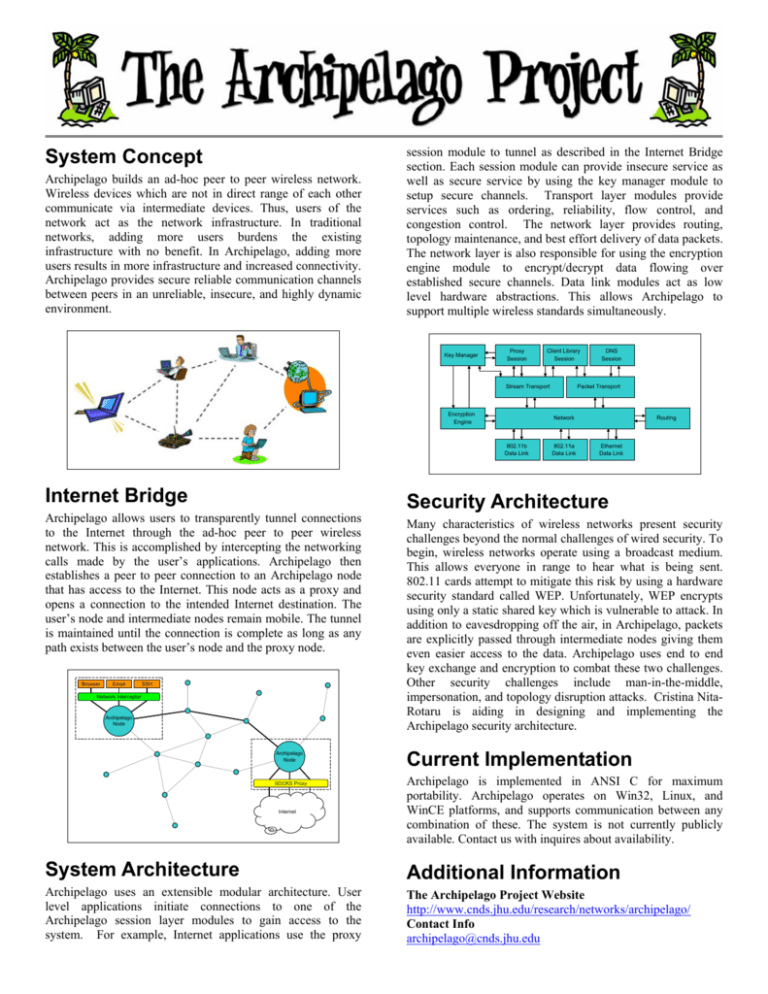System Concept Internet Bridge System Architecture Security
advertisement

System Concept Archipelago builds an ad-hoc peer to peer wireless network. Wireless devices which are not in direct range of each other communicate via intermediate devices. Thus, users of the network act as the network infrastructure. In traditional networks, adding more users burdens the existing infrastructure with no benefit. In Archipelago, adding more users results in more infrastructure and increased connectivity. Archipelago provides secure reliable communication channels between peers in an unreliable, insecure, and highly dynamic environment. session module to tunnel as described in the Internet Bridge section. Each session module can provide insecure service as well as secure service by using the key manager module to setup secure channels. Transport layer modules provide services such as ordering, reliability, flow control, and congestion control. The network layer provides routing, topology maintenance, and best effort delivery of data packets. The network layer is also responsible for using the encryption engine module to encrypt/decrypt data flowing over established secure channels. Data link modules act as low level hardware abstractions. This allows Archipelago to support multiple wireless standards simultaneously. Key Manager Proxy Session Client Library Session Stream Transport Encryption Engine Archipelago allows users to transparently tunnel connections to the Internet through the ad-hoc peer to peer wireless network. This is accomplished by intercepting the networking calls made by the user’s applications. Archipelago then establishes a peer to peer connection to an Archipelago node that has access to the Internet. This node acts as a proxy and opens a connection to the intended Internet destination. The user’s node and intermediate nodes remain mobile. The tunnel is maintained until the connection is complete as long as any path exists between the user’s node and the proxy node. Browser Email SSH Network Interceptor Archipelago Node Archipelago Node SOCKS Proxy Internet Packet Transport Network 802.11b Data Link Internet Bridge DNS Session 802.11a Data Link Routing Ethernet Data Link Security Architecture Many characteristics of wireless networks present security challenges beyond the normal challenges of wired security. To begin, wireless networks operate using a broadcast medium. This allows everyone in range to hear what is being sent. 802.11 cards attempt to mitigate this risk by using a hardware security standard called WEP. Unfortunately, WEP encrypts using only a static shared key which is vulnerable to attack. In addition to eavesdropping off the air, in Archipelago, packets are explicitly passed through intermediate nodes giving them even easier access to the data. Archipelago uses end to end key exchange and encryption to combat these two challenges. Other security challenges include man-in-the-middle, impersonation, and topology disruption attacks. Cristina NitaRotaru is aiding in designing and implementing the Archipelago security architecture. Current Implementation Archipelago is implemented in ANSI C for maximum portability. Archipelago operates on Win32, Linux, and WinCE platforms, and supports communication between any combination of these. The system is not currently publicly available. Contact us with inquires about availability. System Architecture Additional Information Archipelago uses an extensible modular architecture. User level applications initiate connections to one of the Archipelago session layer modules to gain access to the system. For example, Internet applications use the proxy The Archipelago Project Website http://www.cnds.jhu.edu/research/networks/archipelago/ Contact Info archipelago@cnds.jhu.edu









